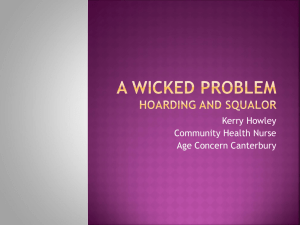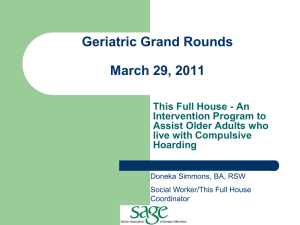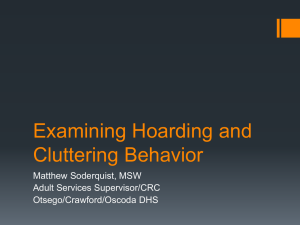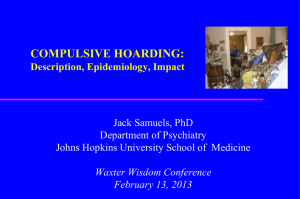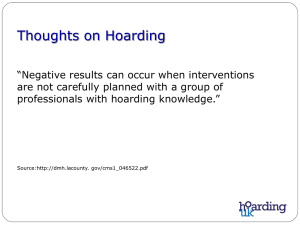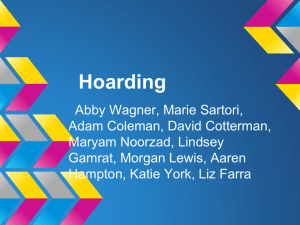Mess and Clutter - Mental Health Services
advertisement
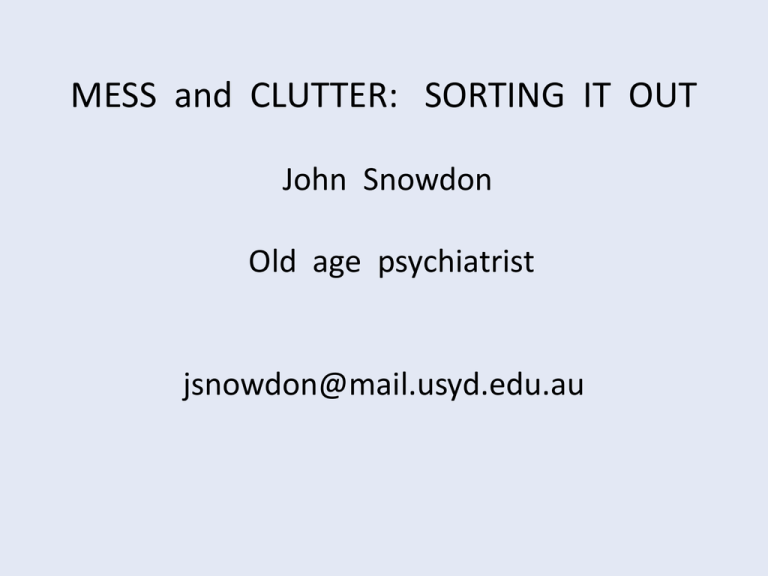
MESS and CLUTTER: SORTING IT OUT John Snowdon Old age psychiatrist jsnowdon@mail.usyd.edu.au Who should take action? • Man aged 60 years, sent on schedule which stated: “Grossly disshevelled, unkempt. Living in profound squalor. Deterioration in hoarding behaviour in recent months. Poor hygiene. He stated that he only has one meal a day and has not changed his clothes for several years. He … slept outside to “protect his privacy”. Denied self-harm or harm to others (yelling at night as well)” • Community team notes: “Referred by neighbour who was concerned about X’s mental state. Has apparently been sleeping under an umbrella outside his house (on front porch). Collects rubbish and fills back yard with it. Has no running water or power. Stays out until 3 a.m., sleeps until midday. According to neighbour, X shouts to himself in the early mornings. Assessed outside front door as client refused to let us in Poor insight. Says he “chooses” to live like that. Does not see a problem”. • In hospital 13 days. CT brain scan normal. Blood tests OK. 2 Psychological report • “Significant impairment on tasks of immediate memory for verbally presented information. On tests of executive functioning X fell within the impaired classification overall… Difficulty focussing his attention, in recalling novel information and with tasks requiring more abstract, higher level processing. He demonstrated poor judgement and impairment in self-direction and selfregulation. This pattern of results may be indicative of a frontal lobe condition.” 3 Who should take action? • 9 years later, referral to community mental health team from the client’s nephew. The family hadn’t seen X for 30 years, but his uncle wanted to see him before he (uncle) dies. When they arrived at the property they found it to be “in squalor” and X was unkempt. • “The neighbours state they have made numerous complaints to council about the rats but nothing has been done. X is sleeping on the front verandah amongst the squalor and accumulated items”. • Hasn’t been in the house for 5 months. Dishevelled, unkempt. Aware he needs to clean up. Orientated. Has money in the bank. Showered. Given new clothes to take home … 4 Meanings of words Collecting Accumulating (eventually amassment) Hoarding Pathological animal collecting (“hoarding”) Environmental neglect (? self-neglect) Severe domestic squalor 5 Aspects of collectionism, self-neglect and severe domestic squalor • Organised and systematic collecting • Compulsive acquisition with little attempt to resist (items may be of value, collected systematically but to excess) • Hoarding: acquisition of, and failure to discard possessions of limited use or value • Accumulation of rubbish • Neglect personal care and home cleanliness • Neglect basic health needs (including medication) • Neglect social needs • Fail to eat/drink enough • Poor care of finances • Fail to protect self from financial or sexual abuse 6 A 2007 review revealed 2 bodies of literature • Literature on squalor. By 2007 there had been 74 case-reports and 15 reports of case-series in health sciences journals. • Literature on hoarding. Various reports, some mentioning squalor, but no research on the prevalence of severe uncleanliness in cases of hoarding. Snowdon, Shah, Halliday (2007) Internat Psychogeriatrics, 19, 37-51. Literature review Macmillan and Shaw (1966). Psychiatric. Senile breakdown in standards of personal and environmental cleanliness Clark et al (1975). Geriatricians. Diogenes syndrome. 30 inpatients, 66-92 Halliday et al (2000). Special cleaning team. Squalor. 91 community residents. 70% had mental disorder. None with OCD. 8 Severe domestic squalor • Squalor: what’s the word mean, and do we want to use it? • What is severe domestic squalor? • Should we be doing something when we encounter people who live in squalor? • Why do some people live in squalor? Severe domestic squalor • Cooney and Hamid (1995) referred to “a reclusive elderly person living alone in a dilapidated filthy house. The home is cluttered with rubbish and infested with vermin. Excrement and decomposing food are strewn around the floors and the stench emanating is unbearable to all but the occupant, who is blissfully unconcerned by the situation.” 10 Severe domestic squalor • Some clinicians suggested there was a syndrome: • Environmental uncleanliness (and often associated personal uncleanliness) and, to a varying extent, • • • • Lack of concern about their living conditions Social withdrawal Hostile attitudes Stubborn refusal of help Severe domestic squalor • We suggest that ‘severe domestic squalor’ is a description of an environment, not of a person . Ratings should not be of the person who lives in that environment, so the person’s characteristics should be noted separately and respectfully . It’s not a syndrome and certainly isn’t a diagnosis! 12 • The term ‘severe domestic squalor’ is applied when a person’s home is so unclean, messy and unhygienic that people of similar culture and background would consider extensive clearing and cleaning to be essential. Accumulations of dirt, grime and waste material extend throughout living areas of the dwelling, along with presence or evidence of insects and other vermin. Rotting food, excrement &/or odours are likely to cause feelings of revulsion among visitors. • As well as accumulation of waste, there may have been purposeful collection and/or retention of items to such a degree that it interferes with occupants’ ability to adequately clean up the dwelling. 13 Why do some people live in squalor? • Maybe they have a mental or physical disorder that makes them incapable of (e.g. weak or had CVA), or unmotivated (maybe newly so, due to frontal lobe damage) to keep their domestic environment clean. • Maybe their vision or sense of smell is impaired. • Maybe their personality is such that they don’t care about uncleanliness & don’t notice filth. (Quntin Crisp ?) • Maybe they’ve never been organised or learnt to clean. • Maybe they come from a culture that sees no need for clean surroundings. • Maybe there are impediments to cleaning – e.g. it’s out of reach or cleaning is obstructed by collected, hoarded or accumulated items. • They might have Hoarding Disorder: very attached to, and difficulty discarding, items – maybe even dirty ones. 14 Diagnoses in 2 studies • Halliday et al (2000): n=81 age range 18-94 Organic mental disorder……22% Substance abuse……………….10% Schiz/delusional disorder….21% Affective disorder……………….5% Anxiety/phobic disorder ….…6% Developmental disabiliy…….11% No diagnosed mental disorder…………………………25% • Snowdon & Halliday (2011): n=120, age 65 years or more Dementia…………………..35% Subst abuse/ARBD …….24% Schiz/paranoid dis……. 15% Depression…………………..3% Personality disorder……. 9% (obsessional 4%) Physical illness……………..8% No DSM or physical disorder ….……5% 15 Severe domestic squalor Descriptions of cases can be grouped according to ‘severity’ (e.g. rated on the ECCS), or into (1) those where accumulation of useless items and articles have obstructed proper care of a person’s living conditions. ‘Dry squalor’. (2) those where filth and refuse have accumulated because of failure to get rid of them. May be filthy without a lot of clutter. May be ‘wet squalor’. (3) Both (1) and (2) 16 Pets • There were pet animals in 42 (25%) of these metropolitan homes: Many cats in one house, 11 birds in another 4 or 5 animals in 3 others 3 or fewer in 37 None in 131. 17 • Many “animal hoarders” live in extremely squalid conditions. • 78% “heavily littered with trash and garbage”, and in 45% there was “profuse urine and feces in the living room”. (Patronek and Nathanson, 2009) 18 Collecting (as opposed to hoarding) is selective object accumulation. Pleasurable: Psychological benefit 19 Our common understanding is that hoarding = storing for future use, or to look at, perhaps Squirrel away? Bower-bird mentality? In recent years, excessive item or material amassment has been widely referred to as hoarding, even when it’s not done purposely and the stuff lacks use or value. 20 Do you hoard a lot? • During your lifetime, have you ever accumulated so many things that your home was very cluttered (to the extent that you could not use some rooms for their intended purpose) and you found it very difficult to discard or give away these items? Screening question in a 2008-10 London Community Health Study 21 Why do some people hoard? • • • • • • • Complex interplay of factors: Genetic Personality Organisational, beliefs, culture, attitudes Neurobiological disturbance (e.g. brain disorder) Perceived value of items: practical, sentimental, intrinsic Erroneous beliefs Attachment issues etc. We need psychologists! 22 Compulsive Hoarding • Some researchers suggested that OCD is the most common reason for people to excessively hoard possessions and then to live in unclean conditions (Saxena et al, 2002; Steketee & Frost, 2003). • However, recent evidence points to compulsive hoarding being a genetically and neurobiologically discrete entity (Saxena, 2007; Pertusa et al, 2008). • It’s been suggested that compulsive hoarding is really an impulse-control deficit rather than a compulsion (Maier, 2004), and anyway, some collect ritualistically rather than compulsively or on impulse. Others don’t collect; they just don’t throw away. Ritualistic collection and unmotivated accumulation of rubbish should not be referred to as hoarding. Hoarding has been defined in the psychological literature as the acquisition of, and failure to discard, possessions of limited use or value. The person (1) actively acquires stuff , (2) purposely keeps it, and (if it’s abnormal/pathological) (3) living spaces become too cluttered for activities for which they were designed. (4) The person’s distressed and there’s significantly impaired ability to function. 24 DSM-5 Hoarding Disorder A. Persistent difficulty discarding items, regardless of actual value B. …due to perceived need to save the items, and distress associated with discarding them, C. …resulting in accumulation of possessions that clutter living areas, thus substantially interfering with function and activities. D. This causes clinically significant distress or impairment in social, occupational or other important areas of functioning. E. Not attributable to a medical condition (brain injury, stroke, etc) F. Not better explained by the symptoms of another mental disorder: cognitive deficits (dementia), low energy (major depression), delusions (schizophrenia), restricted interests (autism), obsessions (OCD). Specify if (a) with excessive acquisition, (b) with good/poor/no insight 25 Normative collecting versus Hoarding Disorder • • • • • • • Normative collecting Selective. Cohesive theme. Narrower range of categories Planned, organised collecting Not usually excessive. Orderly display of collection Distress rare (e.g. due to cost) Minimal social impairment; collecting adds to social life No significant work impairment • • • • • • • Hoarding Disorder Non-selective. Lots of different categories Lack of planning or focus Commonly excessive. Free/Bought Disorganised clutter Distress is very common Severe social impairment; often single, social withdrawal Occupational impairment common 26 Prevalence of Hoarding Disorder • 1.6% of 1698 a South East London population aged between 16 and 90 years fulfilled criteria for Hoarding Disorder. • Studies (mainly in the US) say that 2% to 6% of adults hoard excessively. But this would include people whose hoarding would be attributable to mental disorders such as dementia, OCD and schizophrenia. 27 Hoarding and squalor • People who collect or hoard may do so in an organised way. YES WE CAN !! • But if they accumulate too much stuff, or if they don’t keep it in an organised way, it may be difficult to keep the storage area (e.g. the whole dwelling) clean: • It gets messy! 28 Some people who hoard excessively don’t keep their dwellings clean 1. If their hoarding is disorganised and very excessive, they may not be able to reach and clean all areas, even if motivated to do so. 2. Some people who hoard excessively do so because they have impaired neuropsychological function that may result in disorganisation, difficulty in discarding, lack of awareness that areas or items are unclean and/or a lack of motivation to clean. 29 Maier (2004) helped us distinguish compulsive hoarding from non-hoarding accumulation • OCD or brain change: collecting too much and then having difficulty discarding. Hoarding. • Impulse-control deficit (e.g. due to brain changes) rather than compulsion. Hoarding. • Ritualistic, grasping behaviour. Collectionism. Not hoarding. • Unmotivated to throw away. Accumulate rubbish. Not hoarding. Maier T (2004) Acta Psychiat Scand 110, 323-337. In various neuropsychiatric disorders (dementia, autism and schizophrenia (OK?) acquisition isn’t compulsive and isn’t due to poor impulse control. It’s “just motor activity without clear intention or aim, hence stereotypic, ritualistic.” People collecting in this way may be indifferent to removal of the items. Maier liked the term ‘collectionism ’ for this behaviour. 31 ‘Organic’ accumulation Hoarding disorder ONSET Sudden or insidious Insidious (from adolescence) ABILITY TO DISCARD Variable. Some don’t care Cannot discard ACQUIRING Often indiscriminate Perceived intrinsic, practical or emotional value SQUALOR Frequent Uncommon PERSONALITY CHANGE Common Not COGNITIVE & EMOTIONAL PROCESSES Disorganised Indecision, abnormal categorisation, behavioural avoidance, attachment to possessions, etc. INSIGHT Poor Ranges from good to poor PREVALENCE < 1% 2–5% FAMILIAL Some reported cases Yes Collecting, hoarding, accumulating, disorganisation, mess, squalor: the OVERLAP • You can collect, hoard &/or accumulate clean stuff in an organised fashion. • You might hoard too much, so that even if it’s fairly well organised, it’s too difficult to keep clean. • You can accumulate rubbishy stuff (‘cos you haven’t got round to discarding it yet). • Disorganised hoarding may result in accumulating messily and living in SQUALOR. • You may accumulate rubbish/waste/garbage / filth by being too laid-back or disabled to throw it out. It’s not purposeful hoarding. Can lead to SQUALOR. 33 Not all those who self-neglect and not all those who hoard live in severe domestic squalor • Some people neglect (seem not to care about) cleanliness of themselves, their dependants or their homes and don’t get rid of rubbish (e.g. some with dementia, schizophrenia, alcoholism). Some are physically or cognitively unable to take action. • Excessive or inappropriate collecting (and especially failure to discard) may lead to difficulty in cleaning. Clutter/accumulation in Central Sydney cases of moderate or severe domestic squalor • Of 115 cases of moderate/severe squalor, the degree of clutter/accumulation was deemed to be minimal or absent in 39 (34%) moderate in 37 (32%) major in 39 (34%) Filth but little object clutter may be wet squalor; item clutter & no faeces etc may = dry squalor! Accumulation/clutter in cases of moderate/severe squalor • There was MINIMAL or no clutter in about half of the cases where we diagnosed substance abuse or alcohol related disorder (and 31% of dementia and 15% of schizophrenia cases). • There was a MAJOR degree of clutter in most (76%) of the cases where we diagnosed personality disorder and no definite DSM-IV mental disorder. 36 37 • The term ‘severe domestic squalor’ is applied when a person’s home is so unclean, messy and unhygienic that people of similar culture and background would consider extensive clearing and cleaning to be essential. Accumulations of dirt, grime and waste material extend throughout living areas of the dwelling, along with presence or evidence of insects and other vermin. Rotting food, excrement &/or odours are likely to cause feelings of revulsion among visitors. • As well as accumulation of waste, there may have been purposeful collection and/or retention of items to such a degree that it interferes with occupants’ ability to adequately clean up the dwelling. 38 ENVIRONMENTAL CLEANLINESS AND CLUTTER SCALE (all items 0,1,2,3) A. ACCESSIBILITY (CLUTTER): Not / somewhat / moderately / severely impaired 0-29%, 30-59%, 60-89%, 90-100% floor-space inaccessible B. ACCUMULATION OF ITEMS of little obvious value (what items?) C. ACCUMULATION OF REFUSE OR GARBAGE: None / little / moderate / lots D. CLEANLINESS OF FLOORS & carpets (excluding toilet / bathroom) E. CLEANLINESS OF WALLS, visible furniture SURFACES & window-sills F. BATHROOM & TOILET: Not / mildly / moderately / very dirty G. KITCHEN & FOOD: Clean / hygienic ……to very dirty / unhygienic H. ODOUR: Nil / pleasant ………………………..to unbearably malodorous I VERMIN: None / Few / Moderate / Infestation [ Define ] J. SLEEPING AREA: Reasonably clean …….to very dirty SCORE (max 30) ………… BATHROOM & TOILET : 0 = Reasonably clean 1 = MILDLY DIRTY Floor, basin, toilet, walls, etc. Toilet may be unflushed. 2 = MODERATELY DIRTY Floor, basin, shower/bath, etc. Faeces and/or urine on outside of toilet bowl. 3 = VERY DIRTY. Rubbish &/or excrement on floor & in bath or shower &/or basin. Uncleaned for months or years. Toilet may be blocked and bowl full of excreta. 40 A. ACCESSIBILITY (clutter): Score 0 1 2 3 Description % of floor-space inaccessible for use or walking across Easy to enter and move about dwelling SOMEWHAT IMPAIRED access but can get into all rooms MODERATELY IMPAIRED access. Difficult or impossible to get into one or two rooms or areas SEVERELY IMPAIRED access – e.g. obstructed front door. Unable to reach most or all areas in the dwelling 0-29% 30 to 59% 60 to 89% 90 to 100% 41 ECCS scores • A total ECCS score of >12 was found to indicate, in most cases, that the occupants were living in moderate or severe squalor. The median ECCS score in cases of SEVERE squalor (as judged by JS and GH) was 22 (inter-quartile range 16 to 24). 42 A useful question regarding clutter? • Tolin et al (2007), in a handbook for those who compulsively acquire, save and/or hoard, asked “To what extent does the clutter in your home prevent you from using parts of your home for their intended purpose? For example, cooking, using furniture, washing dishes…....” Tolin DF, Frost RO, Steketee G (2007). Buried in Treasures. Help for Compulsive Acquiring, Saving and Hoarding. Oxford: Oxford University Press. Interventions • Reports suggest that agencies worldwide are generally uncoordinated and consequently inefficient when trying to intervene and help in cases of squalor. Insufficient attention, resources and research have been committed to improving our understanding and interventions. 44 NSW Squalor Guidelines • Expression of interest and meetings between Mercy Arms & Central Sydney Area Health (similar previous interactions between South Eastern Sydney Area Health & Waverley Council) • Funding provided by Dept. of Ageing, Disability & Home Care (DADHC) • Project Officer appointed • Reference Group convened 45 NSW squalor guidelines (process) • Reference Group Meetings (Dec 03-Sept 04) – Brainstorming – Discussion – Sample Cases – 30-item survey of participants/organizations • Legal review • Consultation with other relevant/interested persons • Preparation of Guidelines – Algorithms (illustration of roles & steps) – Benefits of a coordinated approach – Role of the key worker or case manager – Shortfalls • Recommendations 46 DIAGRAM 1: ASSESSMENT & MANAGEMENT OF PEOPLE LIVING IN SQUALOR POSSIBLE INTERVENTIONS E. Individual work & case Management (4;8) C. TAKE IMMEDIATE ACTION IF REQUIRED 1. For person (eg transfer to hospital) 2. Dependents (eg refer to DOCS, RSPCA) (5.5;7.2-7.4) A. REFERRAL Obtain background information: including potential OH&S issues (2.2;3;6) B. HOME VISIT 1. Assessment of · Level – squalor · Risk · Person · Dependents · Capacity 2. Engage & gain trust of person (4; 5.1-5.2;2.2;10.3) F. Cleaning (7.8) D. JOINT AGENCY CASE CONFERENCE Convene meeting with delegates from relevant services to determine action plan, within context of; 1. Persons physical/mental health 2. Capacity Does the person have impaired decision making re accommodation, services, health and or Financial management. 3. Acceptance of assistance. (4;8;10.3) RESISTS HELP or LACKS CAPACITY REFUSES ASSESSMENT PEOPLE WHO RESIST ASSESSMENT OR HELP SEE DIAGRAM 2 G. Medical & psychiatric services (2.62.7;7.2-7.4) H. Home services (7.5) L. CONTINUING FOLLOW UP & SUPERVISION TO PREVENT RECURRENCE. (Case management; NGO services; Community Treatment Order & Mental Health; GP) (5.6;7.47.7;10.6) I. Council services (5.2;7.1) J. DOH (7.6) K. Residential care (7.4) FURTHER DETAILS A-L: See explanatory notes 2.2-10.6 Relevant sections of Guidelines Page 1 47 Assessment and management of people living in squalor • • • • • • Referral Home visit Take immediate action if required Joint agency case conference Possible interventions (e,f,g,h,i,j,k) People who resist assessment or help: consider Mental Health Act, Local Government Act, Residential Tenancy Act, guardianship, etc. • Continuing follow-up and supervision to prevent recurrence 48 Possible interventions • Individual work and case management (flexible and supportive). Care re OH&S issues • • • • • • Cleaning Medical and psychiatric services Home services Council services Department of Housing Residential care 49 Occupational health and safety • • • • • • • • • Is the structure of the building safe and secure? Are there damaged electric wires trailing …. ? Are there sick or aggressive animals in the dwelling? Are there fire hazards? Has there been spillage: urine, faeces, grease, liquids? Is there a health risk? (mould, ammonia, pathogens) Is personal protective equipment required? Are exits from the home blocked? Etc. 50 Should we intervene? • “There is good reason to agree with Sutherland and Macfarlane’s (2014) view that health workers have a responsibility to be proactive. From experience, it is clear that not only health practitioners but local council officers and community service personnel commonly shy away from enforcing interventions in squalor and hoarding cases in spite of observed effects of their behaviour on neighbours, cohabitants and pets. Sometimes the necessary applications to courts and Tribunals prove too difficult or too expensive.” • Snowdon J (2014). ANZ Journal of Psychiatry. Commentary 51 DIAGRAM 2: PEOPLE LIVING IN SQUALOR RESISTING ASSESSMENT OR HELP PERSON WHO RESISTS ASSESSMENT OR HELP MEDICAL & PSYCHIATRIC ASSESSMENT (See G;7.2;7.4) NO, lacks capacity M. DO THEY HAVE CAPACITY? (2.2;10.1;10.3) YES, has capacity DON’T KNOW O. KEY WORKER/CASE MANAGER TO CONTINUE TO LIAISE & persuade person to accept help (4) N. CANNOT EVEN ASSESS CAPACITY BECAUSE PERSON REFUSES TO OPEN DOOR OR SPEAK TO PEOPLE Consider; 1. Mental Health Act, Section 27 Assessment (if evidence of likely mental illness, apply to Magistrate for order to conduct assessment of patient in presence of Police) 2. Council can order inspection (with Police) under Local Government Act 3. DOH or Landlord can apply to conduct inspection under Residential Tenancy Act (5.1-5.2;10.4;10.6) Q. Apply for a GUARDIAN to be appointed to make decisions about health & accommodation (in consultation with case manager etc.) and/or R. Use Mental Health Act to COMPEL TREATMENT (10.7;11.2;7.2;10.6) Guardian can make decisions about INTERVENTIONS including CLEANING & MEDICAL TREATMENT (SEE DIAGRAM 1) S. Apply for FINANCIAL MANAGER to be appointed (10.7-10.8;11.2) Financial Manager can make decisions about ACCESS TO PROPERTY, CLEANING & PAYMENT FOR CLEANING (SEE DIAGRAM 1) REFER TO COUNCIL P. ENVIRONMENTAL HEALTH OFFICER (± FIRE BRIGADE, RSPCA, POLICE) ASSESSMENT of risk to neighbours & community (5.2-5.5;7.1) If unsuccessful CONTINUING FOLLOW UP & SUPERVISION To prevent recurrence. (SEE DIAGRAM 1) SUBSTANTIAL PROBLEM eg fire risk, rodents, infestation USE APPROPRIATE LEGISLATION (DETERMINED BY PROPERTY OWNERSHIP) to compel owner/ occupant to remove risk & permit cleaning (See P;10.410.5;10.10-10.11) FURTHER DETAILS M-S: See explanatory notes 2.2-11.2 Relevant section of Guidelines Page 1 52 NSW Squalor Guidelines: Recommendations 1 • Publication and distribution of guidelines • Education to health, welfare and housing workers re assessment of risk, engaging clients, means by which to gain access • Need to develop risk management strategies, home assessment tools, hazard identification • Appointment of an experienced community worker to act as a coordinator who could provide information, collect data, provide support 53 Recommendations (cont) • Service agreements between organizations including development of lines of communication and information management strategies /protection of confidentiality • Development and maintenance of local lists of cleaning services • Need for additional and recurrent funding for management • Further research including aetiology, interventions, time taken to intervene, costs, early identification of cases, nature of problem in rural settings • Reconstitution of the Reference Group as an Advisory Committee 54 • Psychiatric services have given insufficient attention to how best to intervene in cases of HOARDING (and particularly Hoarding Disorder). What about CBT or motivational interviewing? What’s the evidence? • Equally, psychologists and associated research teams haven’t been rating and thinking about squalor associated with hoarding. 55 Treatment for compulsive hoarding • Strategies to overcome compulsive hoarding have been demonstrably effective (Steketee & Frost, 2006), and could well be helpful in some cases of squalor where hoarding is regarded as a major contributory factor. Steketee G, Frost RO (2006) Compulsive Hoarding and Acquiring: Workbook. Oxford: Oxford University Press. • Hoarding Task Forces in the US have run conferences, and convene groups to work on decluttering. CBT is useful. Organisers are available in the US and here. In Buried in Treasures, Tolin et al provide a series of photographs of cluttered rooms so that people can rate the amount of clutter . • The Cumberland Anxiety Disorders Unit provided decluttering workshops in 2005-6. Melbourne experts Kyrios and Mogan. • CCHS holds a list of NSW psychologists willing to treat hoarding. Jessica Grisham (UNSW) has written widely. 56 Accommodation of Central Sydney subjects living in unclean conditions MILD (or data incomplete) MODERATE or SEVERE TOTAL Department of Housing 20 49 69 Owner-occupied 20 (or owned by close relative) (43%) 49 69 (43%) Private rental 1 8 9 Boarding-house or NGO-run Unknown 4 7 11 2 0 2 47 113 160 TOTAL Co-habitation of people living in unclean conditions in Central Sydney • 125 subjects (78%) lived alone • In 8 households there were two persons aged 65+ living together (6 married couples, a son with mother, 2 male friends), all 16 being included in our data-base • 19 subjects lived with others aged <65 • None of those subjects rated as living in severe squalor were living with someone, but 22 (10 being both 65+) of those in moderate squalor were living with others. One-year outcome • Sydney subjects referred in 2000-2006 were followed up after 1 year: • 59 (56%) were still living at home, of whom 38 were living in moderate/severe squalor, and 21 mild. Few of the homes were judged to be much cleaner at 1 year. • 28 (27%) had moved to residential care, of whom 25 had been living in mod/severe squalor. • 8 (8%) had died, 5 being in mod/severe squalor. • 10 (9%) (7 being in mod/severe squalor) had moved, mostly to live with relatives. 59 Prevalence/incidence • The population of persons aged 65+ living outside aged care facilities in Central Sydney (Eastern sector) is about 18,000. • The incidence of cases of people 65+ living in moderate/severe squalor = 0.7 per 1000 • These are cases referred to an old age psychiatry service; the number of non-referred cases can only be guessed. Some were referred but refused to see us. • Because over half of those referred are found to be still at home after one year, the prevalence of people aged 65+ living in moderate or severe domestic squalor at about 1.5 per 1000. 60 Comparison with Halliday et al’s data • Subjects in the London study had been referred (mainly by social services) to a special duty cleaning service, provided only for people of limited means. Most (94%) were renting from the local council or housing association. In Sydney, 41% of the subjects were in public housing. • London subjects were aged 18–94 (mean 63) years, whereas ours were all aged 65 +. • LCRS mean (range): 17 (6 to 34) in London, 17.7 in Sydney. • Male: 72% in London, 65% in Sydney. • Single: 54% in London, 39% in Sydney. • Living alone: 84% in London, 78% in Sydney 61 Points to consider The prevalence of cases of severe domestic squalor among older people is about 1 per 1000. Younger people, too, may live in squalor. In a majority of cases there is clutter (either rubbish or accumulated articles), but some live in uncluttered ‘wet’ squalor. Interventions are often uncoordinated. Guidelines and a new rating scale (the ECCS) may help services to provide appropriate care. People have the right to live in the way they choose, providing it is legal and not harmful to themselves or others. Most people who purposely HOARD (acquire and then purposely retain items) do not live in squalor. Some do. NSW legislation & severe domestic squalor – Mental Health Act, 2007 • Section 19, mentally ill or mentally disordered • Section 23, Magistrates order for medical examination or observation where physically inaccessible – Guardianship Act, 1987 • disabilities (e.g. dementia, mental retardation) which limit decision making capacity and may result in neglect – Local Government Act, 1993 • ‘to do work on land or premises not in a safe or healthy condition’ • Amended in 2006 to include a new order 22A (Waste Removal Orders) allowing council to issue an order to remove or dispose of waste on a residential premises that is likely to cause a threat to public health or the health of the individual. This can be issued to an owner or occupier of the premises. – Residential Tenancy Act, 1987 • DOH or Landlord can apply under act to inspect property and carry out repairs – Public Health Regulation, Public Health Act, 1991 • prosecution where excessive vermin infest premises – Nuisance Action, Common Law • neighbours property significantly impinges upon own e.g. squalor, water, smell – Inebriates Act, 1912
